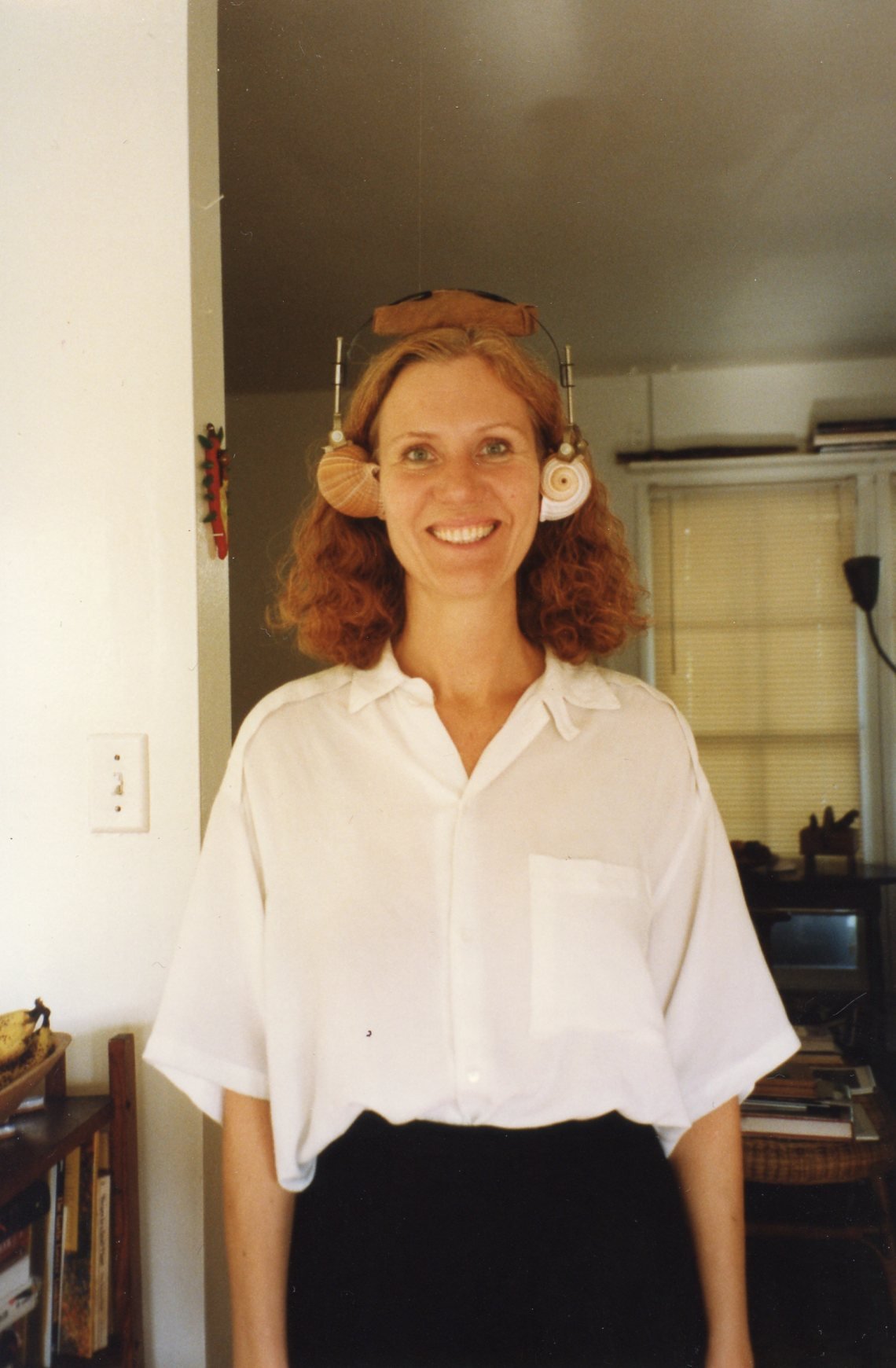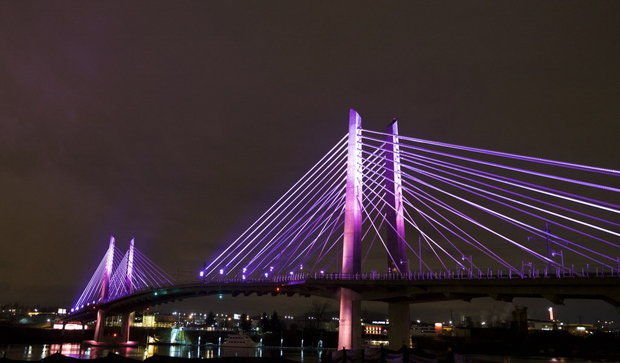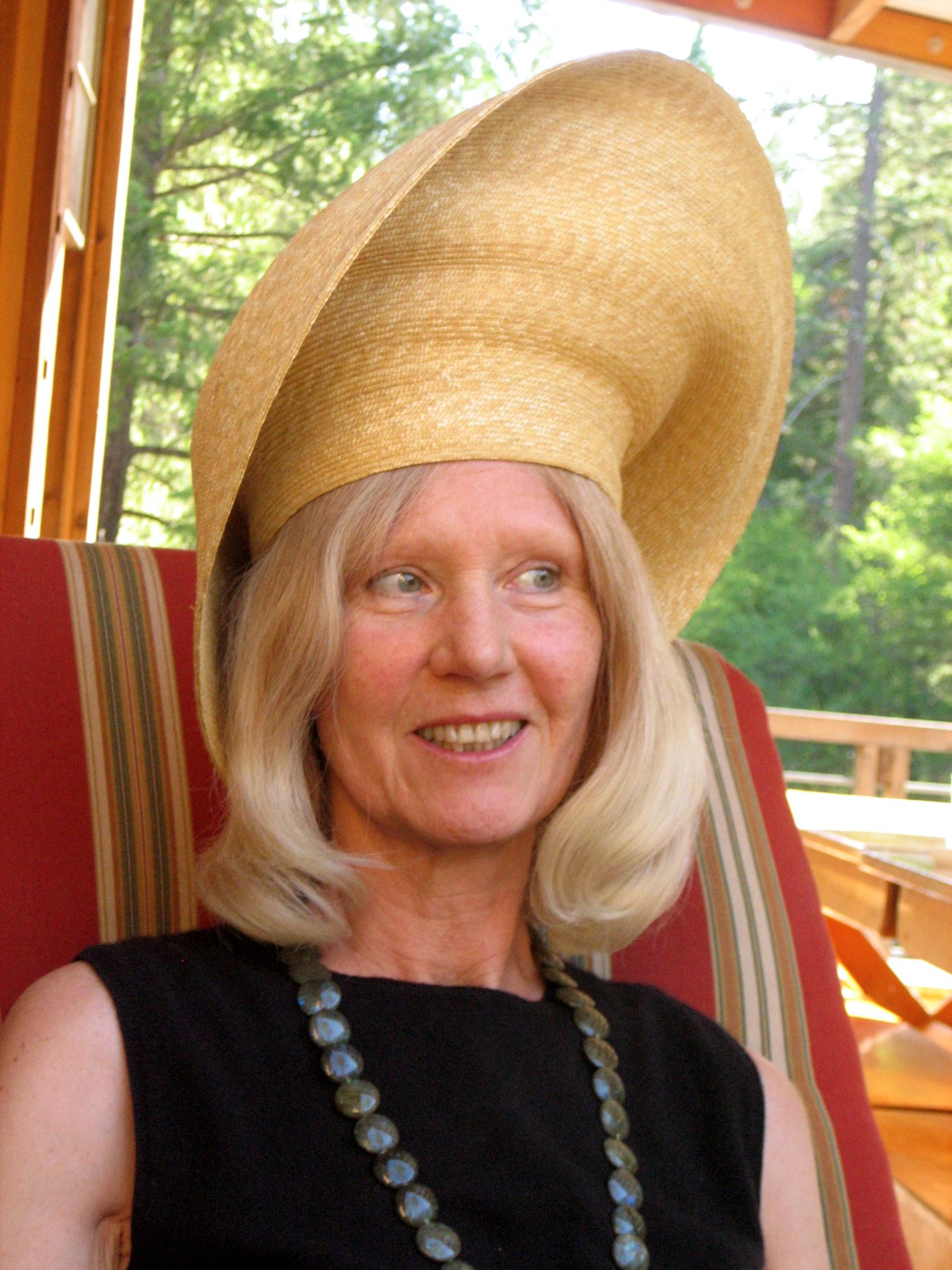Anna the Almaziful: Remembering Anna Valentina Murch (1949-2014)
 On Friday nights, the Sabbath prayer that my husband and I recite is from James Joyce’s Finnegan’s Wake. We light the candles and chant: “In the name of Anna the Almazifull, the Everliving, the bringer of plurabilities…” and as we praise Anna’s “haloed eve,” I think of my beautiful friend, Anna Valentina Murch, who died this year. It's been nine months; I’m having a hard time believing she’s gone.She was lovely, my friend. Playful. An artist through and through. Anna’s house on the peak of San Francisco’s Bernal Hill, shared with her husband and collaborator – Doug Hollis-- was full of candles and mirrors, living room windows open to the glittering city below. Anna loved light and shadows; harnessed them to great effect in her installations for museums and public spaces over the last decades. Her lighting design for Portland’s new Tillicum Bridge (with Doug) completed after her death, casts jewel-colored beams of light above into the night sky and below, onto the surface of the Willamette River.
On Friday nights, the Sabbath prayer that my husband and I recite is from James Joyce’s Finnegan’s Wake. We light the candles and chant: “In the name of Anna the Almazifull, the Everliving, the bringer of plurabilities…” and as we praise Anna’s “haloed eve,” I think of my beautiful friend, Anna Valentina Murch, who died this year. It's been nine months; I’m having a hard time believing she’s gone.She was lovely, my friend. Playful. An artist through and through. Anna’s house on the peak of San Francisco’s Bernal Hill, shared with her husband and collaborator – Doug Hollis-- was full of candles and mirrors, living room windows open to the glittering city below. Anna loved light and shadows; harnessed them to great effect in her installations for museums and public spaces over the last decades. Her lighting design for Portland’s new Tillicum Bridge (with Doug) completed after her death, casts jewel-colored beams of light above into the night sky and below, onto the surface of the Willamette River. Anna and I held an Old Country in common; though hers was probably more Nabokov’s White Russia and mine hewed more to the shtetles that Isaac Babel described in his diary. Her mother’s family was from St. Petersburg, and fled to Shanghai after the Revolution (when my grandparents emigrated to the Lower East Side). During the second World War, Anna’s father—a British naval officer—was stationed in Shanghai, and fell in love and then married Anna’s mother—a beautiful red-haired Russian actress.Her mother, Valentina, played a role in the 1948 film of Anna Karenina, and, like the romantic title character, eschewed the maternal role. Anna was packed off to a strict English boarding school at the age of three. Her liberation came in her twenties, art school and graduate work in lighting and architecture in London. Her adventurous spirit brought her to the U.S, to San Francisco.Her first art works as a newcomer to the American West in 1976 were in the desert. She planted glass rods in the shifting gypsum sands of White Sands, New Mexico, a test missile site. Where did one space begin and other end? How could beauty co-exist with destruction? Light with dark? The presence of geological shiftings and fault lines in her adopted land, both geological and psychological, engendered a series of “volcanica” installations, red neon illuminating black coal. Anna always wanted to know, wanted us to wonder, what lay underneath the surface of things?“I want things to unfold slowly,” Anna once said of her installations. “Often my things are quiet and simple enough that it takes time—a kind of slow overlapping—before people feel it.” She wanted to make time palpable. In her installation, “Voyages” at the San Francisco Museum of Modern Art, you entered a small room, crunching underfoot stones washed smooth from years of river time. You could feel time in your feet.From early childhood, she was fascinated by ruins and abandoned buildings, old barns in the Devon countryside she knew well, stone houses in north England, bombed out residences in London. Who had lived there? What secrets and memories had been shared in what were now the empty shells of dwellings? The remnants of a structure often provided the basis for an imagined archeology. She was also consistently fascinated with psychological thresholds, boundaries, and what it was that empowered people to cross over them.She built her “Staged Garden,” on the crumbling concrete foundations of an abandoned lot in downtown San Francisco. At night, the installation was entirely transformed by gelled theater lights, hidden in the long grass, which illuminated the stage and left long low shadows. A “stage door” lit by blue neon—though sealed-- beckoned from a niche of weathered bricks. To explore the piece as a spectator, you became a performer. And part of the performance was the sight of bejeweled opera patrons promenading past the empty ghost stage on their way the San Francisco Opera House two blocks away.Anna loved dressing up, giving dinner parties, inviting friends for Twelfth Night with the house glittering with candles and redolent with savory aromas from their kitchen. She adored hats, silver sandals, a jacket with a good cut. Even when she had to wear a wig, she did it with style.
Anna and I held an Old Country in common; though hers was probably more Nabokov’s White Russia and mine hewed more to the shtetles that Isaac Babel described in his diary. Her mother’s family was from St. Petersburg, and fled to Shanghai after the Revolution (when my grandparents emigrated to the Lower East Side). During the second World War, Anna’s father—a British naval officer—was stationed in Shanghai, and fell in love and then married Anna’s mother—a beautiful red-haired Russian actress.Her mother, Valentina, played a role in the 1948 film of Anna Karenina, and, like the romantic title character, eschewed the maternal role. Anna was packed off to a strict English boarding school at the age of three. Her liberation came in her twenties, art school and graduate work in lighting and architecture in London. Her adventurous spirit brought her to the U.S, to San Francisco.Her first art works as a newcomer to the American West in 1976 were in the desert. She planted glass rods in the shifting gypsum sands of White Sands, New Mexico, a test missile site. Where did one space begin and other end? How could beauty co-exist with destruction? Light with dark? The presence of geological shiftings and fault lines in her adopted land, both geological and psychological, engendered a series of “volcanica” installations, red neon illuminating black coal. Anna always wanted to know, wanted us to wonder, what lay underneath the surface of things?“I want things to unfold slowly,” Anna once said of her installations. “Often my things are quiet and simple enough that it takes time—a kind of slow overlapping—before people feel it.” She wanted to make time palpable. In her installation, “Voyages” at the San Francisco Museum of Modern Art, you entered a small room, crunching underfoot stones washed smooth from years of river time. You could feel time in your feet.From early childhood, she was fascinated by ruins and abandoned buildings, old barns in the Devon countryside she knew well, stone houses in north England, bombed out residences in London. Who had lived there? What secrets and memories had been shared in what were now the empty shells of dwellings? The remnants of a structure often provided the basis for an imagined archeology. She was also consistently fascinated with psychological thresholds, boundaries, and what it was that empowered people to cross over them.She built her “Staged Garden,” on the crumbling concrete foundations of an abandoned lot in downtown San Francisco. At night, the installation was entirely transformed by gelled theater lights, hidden in the long grass, which illuminated the stage and left long low shadows. A “stage door” lit by blue neon—though sealed-- beckoned from a niche of weathered bricks. To explore the piece as a spectator, you became a performer. And part of the performance was the sight of bejeweled opera patrons promenading past the empty ghost stage on their way the San Francisco Opera House two blocks away.Anna loved dressing up, giving dinner parties, inviting friends for Twelfth Night with the house glittering with candles and redolent with savory aromas from their kitchen. She adored hats, silver sandals, a jacket with a good cut. Even when she had to wear a wig, she did it with style.  She was explicit as to what I meant to her as a friend. We talked about artist- husbands and the demands of our jobs (she was a much-loved professor of art at Mills College for two decades), about balancing our responsibilities while trying to do our own creative work.On our last visit, in January, we took a slow walk around Bernal Hill, leaving “the boys” as we called them, to their own pace. We sat on a bench and looked out over the city. She told me she knew she didn’t have much time. I wanted to push it away, to say that wasn’t so, but I couldn't. it was likely true. She still had good days, like the previous week, which ended with Anna and Doug strolling arm in arm on the sand, tide lapping around their bare feet, in Pacifica. I reached them by cell, their voices were happy,light. They’d made it to the beach without having to walk down steps. Doug said they would go there again, it was so easy.“Space is our friend, but time has death in it,” the poet Gaston Bachelard has written. Perhaps the fact that much of Anna’s art was a meditation on time helped her cross the threshold from this world with what appeared as equanimity. She told me she was not afraid of death, and I believed her. The more time you spend in a space, she once said, the more choices you have in what you see and how you see it. She had bravely struggled with, lived with breast cancer for years. She worked in the garden and together with Doug on their collaborative public art projects almost to the last day. She spoke on the phone to old friends here and in England. As Doug said, “She used her time very wisely.”On that day in January, our last visit, in the late afternoon, the four of us brought deck chairs up to the garden, leaning back to catch the last rays of winter sun, clocks of our life spans ticking. Anna shoulder to shoulder with Lloyd to the right; Doug next to me on the left end. It was a sweet and unburdened hour, four friends talking quietly or sitting in companionable silence as we might have on a trip together to Yosemite or Joshua Tree. We left in early evening, so that Anna could get some nourishment, so that we could drive across the Bay Bridge and relieve the babysitter at our nephew’s house. We said goodbye with such tenderness, pushing hard against the thought that this could be the last time we’d see each other face to face in this world.In the name of Anna, the Almaziful, The Everliving, The bringer of plurabilitiesHaloed be her eve! Her sing time sung,her rill be run, unhemmed, as it is uneven.
She was explicit as to what I meant to her as a friend. We talked about artist- husbands and the demands of our jobs (she was a much-loved professor of art at Mills College for two decades), about balancing our responsibilities while trying to do our own creative work.On our last visit, in January, we took a slow walk around Bernal Hill, leaving “the boys” as we called them, to their own pace. We sat on a bench and looked out over the city. She told me she knew she didn’t have much time. I wanted to push it away, to say that wasn’t so, but I couldn't. it was likely true. She still had good days, like the previous week, which ended with Anna and Doug strolling arm in arm on the sand, tide lapping around their bare feet, in Pacifica. I reached them by cell, their voices were happy,light. They’d made it to the beach without having to walk down steps. Doug said they would go there again, it was so easy.“Space is our friend, but time has death in it,” the poet Gaston Bachelard has written. Perhaps the fact that much of Anna’s art was a meditation on time helped her cross the threshold from this world with what appeared as equanimity. She told me she was not afraid of death, and I believed her. The more time you spend in a space, she once said, the more choices you have in what you see and how you see it. She had bravely struggled with, lived with breast cancer for years. She worked in the garden and together with Doug on their collaborative public art projects almost to the last day. She spoke on the phone to old friends here and in England. As Doug said, “She used her time very wisely.”On that day in January, our last visit, in the late afternoon, the four of us brought deck chairs up to the garden, leaning back to catch the last rays of winter sun, clocks of our life spans ticking. Anna shoulder to shoulder with Lloyd to the right; Doug next to me on the left end. It was a sweet and unburdened hour, four friends talking quietly or sitting in companionable silence as we might have on a trip together to Yosemite or Joshua Tree. We left in early evening, so that Anna could get some nourishment, so that we could drive across the Bay Bridge and relieve the babysitter at our nephew’s house. We said goodbye with such tenderness, pushing hard against the thought that this could be the last time we’d see each other face to face in this world.In the name of Anna, the Almaziful, The Everliving, The bringer of plurabilitiesHaloed be her eve! Her sing time sung,her rill be run, unhemmed, as it is uneven.  [top photo: Anna, SF, wearing Jim Pomeroy's shell earphones… they really work!]
[top photo: Anna, SF, wearing Jim Pomeroy's shell earphones… they really work!]